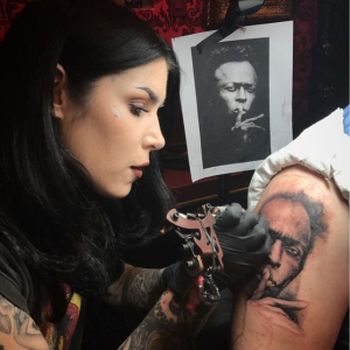Tattoos and fair use. Again. (See this post from last month.)
The plaintiff Jeffrey Sedlik is a photographer who took (and owns the copyright in) this iconic photo of Miles Davis. The defendant is tattoo artist Katherine Von Drachenberg, better known as Kat Von D, famous for her star turn on the reality show LA Ink and her general ferocity. Ms. Von D used Sedlik's photo as a reference when she inked a design on the upper arm of her friend Blake Farmer (at no charge). (My partner Jeremy Goldman wrote about this case when the complaint was filed.)
Sedlik sued, alleging (among other things) the following separate acts of infringement: (1) the inking of the design on Farmer's arm, (2) the creation of a line design (essentially a tracing of the photo) that was used as a stencil to transfer the drawing onto Farmer's skin, (3) the publication on social media of photos that documented the process of inking the tattoo on Farmer's arm (the "process photos") and (4) the publication on social media of a photo that showed the completed tattoo (the "completed photo").
For context, here is one of the process photos posted on Ms. Von D's Instagram, with Sedlik's photo visible in the background:

Last year, both parties moved for summary judgment on the copyright infringement claims. Sedlik argued that the tattoo design was an unauthorized derivative work, and Ms. Von defended on fair use grounds. In May of 2022, District Judge Dale S. Fischer (C.D. Cal) issued an opinion in which she concluded that because there were disputed issues of fact on the first and fourth statutory fair use factors (see 17 U.S.C. § 107), "the issue of fair use as to the Tattoo and the associated social media posts is more appropriately left to a jury."
Both parties moved for reconsideration following SCOTUS's opinion in Andy Warhol Foundation v. Goldsmith (see this post). Concluding that Warhol represented "a material change in controlling law" that "changes the Court's analysis," the court granted the motion. And while Judge Fischer stood by her original holding that disputed questions of fact precluded summary judgment on the fair use defense, she concluded that Warhol mandated that her prior opinion be modified in two respects.
- First, the court noted that Warhol requires that the fair use defense be considered separately for each specific use by Ms. Von D of Sedlik's photo. Since that was something the court had not done in its original order, the court proceeded to address each use separately in its new opinion.
- Second, as described below, the court concluded that its prior order did not analyze the question of transformativeness under the first fair use factor in a manner consistent with Warhol.
The Tattoo Itself: Transformative After Warhol?
In its prior ruling, the court held that Ms. Von D had presented evidence sufficient to allow a jury to conclude that she had made a transformative use of Sedlik's photo when she created the tattoo, explaining:
"The Court finds Defendants have met their burden of showing the Tattoo has a purpose or meaning distinct from that of the Portrait by virtue of the way Kat Von D changed its appearance to create what she characterizes as adding movement and a more melancholy aesthetic. However, Sedlik disputes whether Kat Von D's rendering of the Tattoo was transformative by virtue of the small changes she made; Sedlik opines that all of the alleged dissimilarities between the Portrait and the Tattoo result from Kat Von D's replication of the Portrait onto a three- dimensional surface (Farmer's arm). The Court finds Sedlik has raised a triable issue as to transformativeness that is more appropriately left to a jury."
On the motion for reconsideration, the court recognized that its prior determination that a jury could find the tattoo to be transformative - based on Ms. Von D's addition of "movement" and a "melancholy aesthetic" - focused on the "aesthetic character of the resulting work." This focus, the court said, was "foreclosed" by Warhol. Instead, Warhol required the court, when applying the first factor, to focus on the "central question" of the purpose of the use of Sedlik's photo. Here, there was no parodic purpose or other commentary on Sedlik's photo; indeed, Ms. Von D admitted that had Sedlik's photo not existed, she would have "just used another image." And Ms. Von D had failed to "point to a transformative purpose that goes beyond that required to qualify as a derivative." Since "the evidence Defendants previously relied on to meet their burden no longer shows a transformative purpose after Warhol, there is now an absence of evidence on the issue."
The court could not, however, conclude as a matter of law that the first statutory factor did not favor fair use since there remained disputed issues of fact concerning whether Ms. Von D's use of Sedlik's photo was commercial. Ms. Von D argued that her use was not commercial since she did not charge her friend for the tattoo; Sedlik argued that the publicity Ms. Von D garnered by posting images of the tattoo on social media served the commercial purpose of building her personal brand and attracting customers to her shop. This issue will have to be decided by a jury.
Warhol did not impact the court's previous ruling on the second factor (the nature of the copyrighted work). However, the court noted (in a footnote) that it had made a "mistake" when it held, in its original opinion, that the second factor favored a finding of fair use because Sedlik's photo had been published previously. Although the court now concluded that the second factor weighed against fair use (because Sedlik's photograph is a creative work), the court noted that the second factor "typically has not been terribly significant in the overall fair use balancing."
And the court left undisturbed its prior finding that third factor (the amount and substantiality of the portion used) weighed against fair use.
The Social Media Posts
The court conducted separate fair use analyses for the process photos and the completed photo. Because Sedlik did not argue in his original summary judgment motion that the line drawing was an infringement, the court refused to consider the issue on this motion for reconsideration.
The Process Photos: Sedlik argued that his original photo and the process photos served the same purpose: to depict Miles Davis. The court found this "doubtful," including because it was difficult in some of the process photos to discern that the emerging tattoo depicted Davis. Nevertheless, the court concluded that there were triable issues of fact as to whether Sedlik's photo and the process photos served a different purpose and function and therefore whether the process photos were transformative. The court also found that there were triable issues of fact on the question of whether Ms. Von D's social posts were commercial under the first factor. The court held that its conclusions on the second and third factors with respect to the tattoo applied with equal force to the social media posts "because the second and third factors consider the original work" and the "same elements and pose copied from [Sedlik's photo] for the Tattoo were necessarily reproduced in the social media posts of the Tattoo." And with respect to the fourth factor (effect on the market), the court concluded that there were triable issues of fact "as to whether the social media posts caused actual market harm to Sedlik, and whether widespread use of the portrait on social media would have an adverse impact on the potential markets for [Sedlik's photo] and its derivatives."
The Completed Photo: The court concluded that "the analysis and conclusions with respect to the first and fourth factor likely differ" between the process photos and the completed photo. However, since neither party provided separate analysis of the fair use factors for the completed photo, "the Court cannot decide whether these social media posts are fair uses as a matter of law." Accordingly, summary judgment was not appropriate.
What's Next?
So, if this case does not settle, the fair use defense will be among the other issues in the case for the jury to decide. I wish the jury - and the lawyers tasked with crafting the complicated jury instructions - the best of luck.
Sedlik v. Drachenberg, No. CV 21-1102 DSF (MRWx), 2023 WL 6787447 (C.D. Cal. Oct. 10, 2023)
This alert provides general coverage of its subject area. We provide it with the understanding that Frankfurt Kurnit Klein & Selz is not engaged herein in rendering legal advice, and shall not be liable for any damages resulting from any error, inaccuracy, or omission. Our attorneys practice law only in jurisdictions in which they are properly authorized to do so. We do not seek to represent clients in other jurisdictions.
